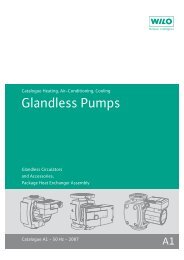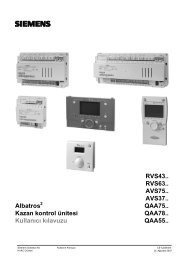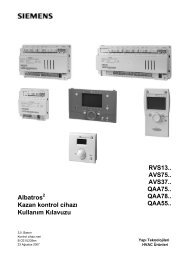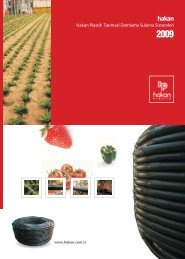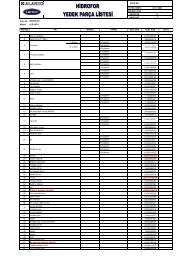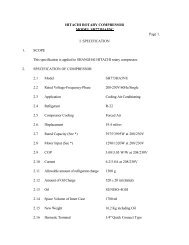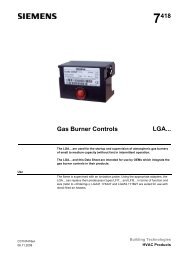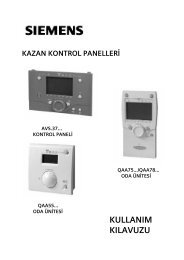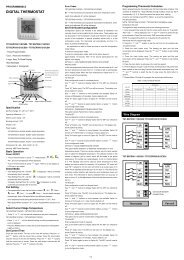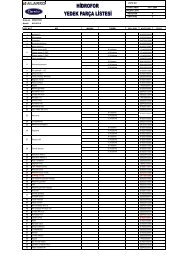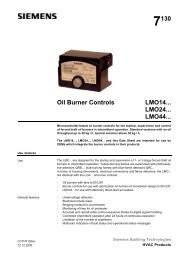A/C Scroll Compressors ZR 90 K4*.....ZR 300 KC*
A/C Scroll Compressors ZR 90 K4*.....ZR 300 KC*
A/C Scroll Compressors ZR 90 K4*.....ZR 300 KC*
Create successful ePaper yourself
Turn your PDF publications into a flip-book with our unique Google optimized e-Paper software.
Fig. 15: Temperature Glide<br />
tc1 dew point } condensing at<br />
t c2 boiling point } p v2 = constant<br />
t02 dew point } evaporating at<br />
t01 boiling point } pv2 = constant<br />
pv1 evaporating pressure<br />
tex<br />
t cm<br />
t0m<br />
pv2<br />
tv1<br />
temperature after expansion valve<br />
mean condensing temperature<br />
mean evaporating temperature<br />
condensing pressure<br />
suction gas temperature at pv1=constant<br />
perature glide. Therefore, certain influences on system design, service and maintenance need to be<br />
considered. The composition of liquid and vapour of a zeotropic blend is different when both liquid and<br />
vapour are present. Therefore it is important that charging is carried out in the liquid phase only. Please<br />
also see the refrigerant manufacturer’s instructions. If a leak occurs there could be a change in composition<br />
of the refrigerant remaining in the system. Large changes in composition can result in decreasing<br />
superheat at the expansion valve leading to liquid returning to the compressor.<br />
Another characteristic of significant composition change can be the appearance of sudden “hunting” of<br />
the expansion valve. Tests by R 407C manufacturers have shown that recharging with the original refrigerant<br />
can typically restore satisfactory system operation simply. If it does not result in satisfactory<br />
system operation, it is recommended to analyse the refrigerant composition in the system prior to replacing<br />
the entire system charge. Working with zeotropic blends requires an understanding of the effect<br />
of temperature glide shown in Fig. 15.<br />
Evaporation at constant pressure takes place with the temperature of the refrigerant increasing from t ex<br />
to t o2 and condensation takes place with a falling temperature from t c1 to t c2 . Thus the terms “evaporating<br />
temperature” and “condensing temperature” must be redefined. High glide causes considerable<br />
temperature differences within the heat exchangers. Similarly, clear definitions for “superheating” and<br />
“subcooling” are needed. Such new definitions are also necessary in order to ensure accurate comparisons<br />
of performance against other azeotropic or near azeotropic refrigerants. Evaporating temperature<br />
is defined as the mean temperature (t om ) between the dew-point temperature (t o2 ) resulting from constant<br />
suction pressure (p v1 ) and the temperature at which the refrigerant enters the evaporator (t ex ).<br />
Condensing temperature is defined as the mean temperature (t cm ) between the dew-point temperature<br />
(t c1 ) resulting from constant discharge pressure (p v2 ) and the boiling-point temperature (t c2 ) of the refrigerant.<br />
The superheating of the suction gas is then calculated as the difference in temperature at the compressor<br />
inlet (t v1 ) and the dew-point temperature (t o2 ) of the refrigerant at suction pressure (p v1 ). It is essential<br />
that these definitions be followed when adjusting the superheat setting of expansion valves.<br />
Liquid subcooling is calculated as the difference between actual liquid temperature and the bubble point<br />
temperature (t c2 ) of the refrigerant at discharge pressure (p v2 ).<br />
The definitions presented here are based on those specified by the Air- Conditioning and Refrigeration<br />
Institute (ARI) as part of their Alternative Refrigerants Evaluation Program (AREP). These definitions<br />
C6.2.2/0701/E 19



